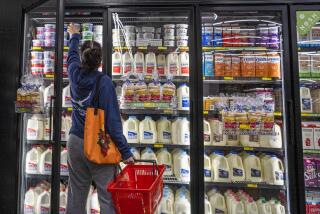Prices Up but Inflation Risk Is Discounted
- Share via
WASHINGTON — Consumer prices, chalking up the worst six-month period of inflation in five years, rose at an annual rate of 5.4% for the first half of 1987, but price hikes appear to have moderated recently, the Labor Department reported Wednesday.
Despite sharp increases in gasoline and food prices, inflation was up a relatively modest 0.4% in June after a 0.3% rise in May.
Tuesday, a rumor had swept through Wall Street that the June consumer price index would jump 0.9%--frightening enough speculators to send bond prices and the U.S. dollar skidding.
4% Inflation Forecast
But most economists now contend that any major resurgence of inflation appears unlikely for the rest of the year, although they expect inflation to run at about a 4% annual rate during the second half. Last year, consumer prices, held down by a collapse in oil prices, were up only a slight 1.9%.
Higher energy prices this year have not yet caused a general rise in inflation, suggesting “that inflation is not ratcheting to higher and higher levels, as was the case in the 1970s,” Lyle Gramley of the Mortgage Bankers Assn. said.
Indeed, excluding the volatile energy and food sectors, inflation was up just 0.2% last month.
But Allen Sinai, chief economist at the Shearson Lehman Bros. brokerage firm in New York, worried that workers are likely to demand higher wages to compensate for the recent price hikes, raising the threat of a new wage-price spiral.
Tough Wage Negotiations
“Inflation of 5% or more would trigger some tough wage negotiations,” he said. “This will be the next battleground on inflation.”
Most economists, though, indicated belief that price increases will moderate in the months ahead. “The (consumer price index report) is basically good news,” said Dana Johnson of First Chicago Corp. “Take out the food and energy, and the core rate of inflation is looking only moderately higher.”
Grocery prices rose a seasonally adjusted 0.8%, with the prices of fresh fruits and vegetables jumping by 3.9% in June. Some economists blamed the recent U.S. immigration law for the rise in fruit and vegetable prices, citing reports that growers are having trouble obtaining workers because fewer illegal aliens from Mexico are crossing the border to pick crops.
Gasoline cost 1.4% more in June, the Labor Department said, and prices for natural gas and electricity jumped 1.8%. But fuel oil prices fell 0.3%. For the first half of 1987, consumer energy costs rose more than 8%, reversing almost half of the 19.7% decline last year.
Medical Costs Rise
The cost of medical care continued its steady climb, rising 0.7% last month and registering a 6.8% increase over the last 12 months--more than twice the increase for the consumer price index.
Overall, the index--which measures how prices change for a fixed market basket of typical items--reached a level of 340.1 in June, meaning that goods and services worth $100 in 1967 cost $340.10 last month.
One surprise in the inflation figures was a sharp drop in apparel prices, which had risen 4.6% in just the first five months of the year, largely because the decline of the dollar has forced importers to push up the price of many foreign goods. But last month apparel prices fell 0.8%, which the Labor Department attributed to price cuts by retailers caught with high inventories.
“Don’t read too much into it,” cautioned Ken Mayland, an economist at First Pennsylvania Bank in Philadelphia. “It’s just a one-month adjustment.”
White House spokesman Marlin Fitzwater said that Wednesday’s report indicates inflation “is returning to the 4% pace reported (in) the first three years of the (current economic) expansion.”
More to Read
Inside the business of entertainment
The Wide Shot brings you news, analysis and insights on everything from streaming wars to production — and what it all means for the future.
You may occasionally receive promotional content from the Los Angeles Times.









